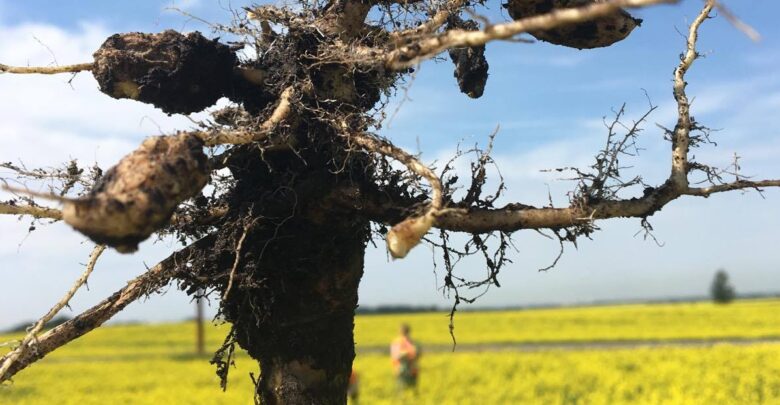 Supplied
SuppliedA new study on clubroot disease from University of Alberta researchers found seven new pathotypes that contribute to the decline in canola field quality.
A pathotype is a disease-causing variant of a micro-organism. Clubroot is a soil-borne pathogen that can rapidly spread, causing premature death to canola. Keisha Hollman, a PhD candidate in the faculty of agricultural, life, and environmental sciences is the lead researcher on this study.
Hollman wants to learn how many pathotypes there are, where they are located, and ways to manage the disease.
A soil-borne pathogen that can rapidly spread
In just one gram of soil, there can be billions of resting clubroot spores that are easily-spread.
“If you have somebody walking in one field with muddy boots and then walking into another, you can spread clubroot. It’s that easy,” Hollman said.
The study was conducted in Manitoba, Saskatchewan, and, Alberta — primarily in Edmonton and Leduc County. According to Hollman, both areas are hotspots for clubroot disease. Hollman said that the disease is being found to spread throughout the rest of the province as well, slowly turning clubroot into an epidemic. She attributed this to the soil types in Alberta as well as the environmental conditions being favourable for the disease.
“That’s why it has become a bit of an epidemic, especially in Alberta. We have seen it spread since its discovery and it continues to spread annually.”
Finding ways to manage the growing epidemic
During the study, when researchers noticed a symptomatic plant in a canola field, they’d pull it and see if there are clubroot galls on the root. The researchers would then begin a collection of samples from that field. Samples were grown in the greenhouse and the galls on the roots were rated on the disease severity index. Then, the pathotypes were categorized by the Canadian Clubroot Differentials (CCD) set, created by Hollman’s supervisor, Stephen Strelkov.
The study was conducted from 2019 to 2020. The researchers found 25 unique pathotypes, seven of which were new. Fifteen of these pathotypes were resistance-breaking. These pathogens are able to break the canola’s resistance to clubroot disease.
Hollman highlighted that the study’s findings are concerning due to the dominance of the resistance-breaking pathotype.
“[This] is concerning because now we have a resistance-breaking pathotype — a new one that is also beginning to dominate the fields that we are finding clubroot in.”
Hollman was inspired to research this pathogen and the affect it has on canola crops after working in crop inspection. Hollman’s reason for focusing on clubroot specifically was because of her personal experience working with canola on the production side.
“With canola being such a huge [economic] driver for Alberta, [it] is a very important area,” Hollman said. “[The clubroot epidemic] sounds awful but there are things we can do. Hopefully it can be a whole industry approach and everybody can work together.”
There are “silver linings or hopeful possibilities that exist,” Hollman says
Hollman acknowledges that these discoveries could potentially induce fear, but said there is no need to be overly concerned. There are only five dominant pathotypes. Researchers are only finding many of the others in one to two fields.
Hollman said that this information will hopefully allow researchers to contain the pathotypes and stop them from becoming dominant. While there is no cure to the disease, there are management strategies for producers and farmers to consider. Practices like sanitation, reducing soil spread, rotating host crops, and early detection are techniques that can prevent and manage clubroot.
“So while it does sound very scary, there are silver linings or hopeful possibilities that exist.”




